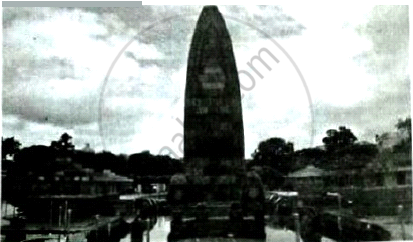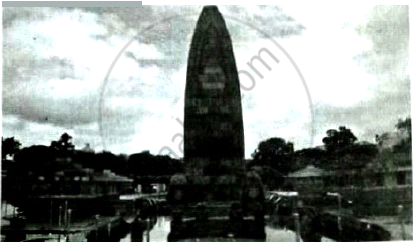(English Medium)
Academic Year: 2018-2019
Date: March 2019
Advertisements
1 . Attempt all questions from this Part I
2. Attempt any Two questions ln Section A
3. Attempt any Three questions ln Section B
What is the normal term of office of the Lok Sabha?
Chapter: [0.01] The Union Parliament
State the meaning of the term Question Hour.
Chapter: [0.01] The Union Parliament
Name the Presiding officer of the Lok Sabha.
Chapter: [0.01] The Union Parliament
State any one condition when the Parliament can legislate on subjects in the State List.
Chapter: [0.01] The Union Parliament
Write any one circumstance when the President can declare a National Emergency.
Chapter: [0.02] The President and The Vice-President
What happens when a motion of ‘No-Confidence’ is passed against a Minister ?
Chapter: [0.01] The Union Parliament
On whose advice can the President appoint the Council of Ministers ?
Chapter: [0.03] Prime Minister and Council of Ministers
What is meant by Appellate Jurisdiction of the Supreme Court ?
Chapter: [0.04] The Supreme Court
On what grounds can a Supreme Court Judge be removed from office?
Chapter: [0.04] The Supreme Court
State one point of distinction between the District Judge and the Sessions Judge.
Chapter: [0.05] The High Courts and Subordinate Courts
What was the General Service Enlistment Act?
Chapter: [0.04] Second Phase of the Indian National Movement
Name the two books that Dadabhai Naoroji authored explaining the ‘Drain of India’s Wealth’.
Chapter: [0.02] Growth of Nationalism
Name of the organisation founded by Jyotiba Phule.
Chapter: [0.02] Growth of Nationalism
Name the organisation founded by Raja Rammohan Roy.
Chapter: [0.02] Growth of Nationalism
Write any two contributions of Lala Lajpat Rai to the National Movement.
Chapter: [0.04] Second Phase of the Indian National Movement
State any two provisions of the Indian Independence Act of 1947 that was to decide the fate of the Princely States.
Chapter: [0.09] Independence and Partition of India
Write any two reasons for the acceptance of the Mountbatten Plan by the Congress.
Chapter: [0.09] Independence and Partition of India
Advertisements
State any two objections imposed by the Treaty of Versailles on the German military power .
Chapter: [0.1] The First World War
Name the Signatory Countries of the Triple Alliance.
Chapter: [0.1] The First World War
What is meant by the term ‘Veto’ power?
Chapter: [0.13] United Nations
Why was the League of Nations established?
Chapter: [0.1] The First World War
The Parliament is the body of peoples representatives who have Supreme power in a democracy. With reference to
the Union Legislature answer the following :
How are the members of the Rajya Sabha elected ?
Chapter: [0.01] The Union Parliament
The Parliament is the body of peoples representatives who have Supreme power in a democracy. With reference to the Union Legislature answer the following :
Why is it called a Permanent house ?
Chapter: [0.01] The Union Parliament
The Parliament is the body of peoples representatives who have Supreme power in a democracy. With reference to the Union Legislature answer the following :
State any two Financial and any two Legislative powers of the Indian Parliament.
Chapter: [0.01] The Union Parliament
The Council of Ministers headed by the Prime Minister, is the most Powerful Institution in the Indian Polity. In this context answer the following :
State briefly the position of the Prime Minister in the Parliamentary system or Government. State any two powers the Prime Minister has as a leader of the Nation.
Chapter: [0.03] Prime Minister and Council of Ministers
The Council of Ministers headed by the Prime Minister, is the most Powerful Institution in the Indian Polity. In this context answer the following:
Distinguish between the Council of Ministers and the Cabinet.
Chapter: [0.03] Prime Minister and Council of Ministers
The Council of Ministers headed by the Prime Minister, is the most Powerful Institution in the Indian Polity. In this context answer the following :
Write any four functions of the ‘Cabinet’.
Chapter: [0.03] Prime Minister and Council of Ministers
India has a single integrated judicial system that is Independent and Supreme. With reference to the Judiciary,
answer the following :
(i) Who appoints the Judges of the High Court ?
(ii) State any two qualifications required for a person to be appointed as a High Court judge.
Chapter: [0.05] The High Courts and Subordinate Courts
India has a single integrated judicial system that is Independent and Supreme. With reference to the Judiciary,
answer the following :
Explain briefly the term ‘Court of Record’ with reference to the High Court.
Chapter: [0.05] The High Courts and Subordinate Courts
India has a single integrated judicial system that is Independent and Supreme. With reference to the Judiciary,
answer the following :
List any four write that the High Court can issue for the enforcement of Fundamental Rights.
Chapter: [0.05] The High Courts and Subordinate Courts
The Second half of the 19th century witnessed the growth of a strong feeling of Nationalism. With reference to the statement, answer the following :
Write any three repressive Colonial policies of the British.
Chapter: [0.02] Growth of Nationalism
Advertisements
The Second half of the 19th century witnessed the growth of a strong feeling of Nationalism. With reference to the statement, answer the following :
State any three ways in which the Press played an important role in developing nationalism amongst Indians.
Chapter: [0.02] Growth of Nationalism
The Second half of the 19th century witnessed the growth of a strong feeling of Nationalism. With reference to the statement, answer the following :
Explain briefly any three differences in the methods adopted between the Early Nationalists and Radicals, in the National Movement.
Chapter: [0.04] Second Phase of the Indian National Movement
With reference to the picture given below, answer the following questions:

- Identify the Memorial built for those who were killed in this incident.
- Where did this incident take place?
- Name the movement launched by Gandhi in 1920 as a consequence.
Chapter: [0.06] Mahatma Gandhi and the National Movement
With reference to the picture given below, answer the following questions :

Explain briefly the reason for the suspension of this particular movement Gandhi in 1922.
Chapter: [0.06] Mahatma Gandhi and the National Movement
With reference to the picture given below, answer the following questions :

State any four impacts of the movement.
Chapter: [0.06] Mahatma Gandhi and the National Movement
With reference to the National Movement from 1930 to 1947, answer the following :
State any three features of the Programmed of the Civil Disobedience Movement launched in 1930.
Chapter: [0.06] Mahatma Gandhi and the National Movement
With reference to the National Movement from 1930 to 1947, answer the following :
What was the significance of the Second Round Table Conference held in 1931?
Chapter: [0.06] Mahatma Gandhi and the National Movement
With reference to the National Movement from 1930 to 1947, answer the following :
State any four clause of the Cabinet Mission Plant of 1946.
Chapter: [0.09] Independence and Partition of India
With reference to the Rise of Dictatorships and the Second World War, answer the following :
State any three reasons for the Rise of Fascism in Italy.
Chapter: [0.11] Rise of Dictatorships
With reference to the Rise of Dictatorships and the Second World War, answer the following:
Explain any three consequences of World War II.
Chapter: [0.12] The Second World War
With reference to the Rise of Dictatorships and the Second World War, answer the following :
Name the two rival blocs that fought against each other during World War II and state its signatory countries.
Chapter: [0.12] The Second World War
The necessity to maintain International peace led to the establishment of the United Nations Organisation. With
reference to the statement, answer the following :
Write any three functions of UNESCO that preserves our ‘Cultural Heritage’.
Chapter: [0.14] Major Agencies of the United Nations
The United Nations Organisation was established to maintain peace and ‘promote social progress and better standards of life in larger freedom.’ With reference to this, explain the following:
The composition of the Security Council.
Chapter: [0.13] United Nations
State any four functions of the General Assembly.
Chapter: [0.13] United Nations
Other Solutions
Submit Question Paper
Help us maintain new question papers on Shaalaa.com, so we can continue to help studentsonly jpg, png and pdf files
CISCE previous year question papers ICSE Class 10 History and Civics with solutions 2018 - 2019
Previous year Question paper for CISCE ICSE Class 10 -2019 is solved by experts. Solved question papers gives you the chance to check yourself after your mock test.
By referring the question paper Solutions for History and Civics, you can scale your preparation level and work on your weak areas. It will also help the candidates in developing the time-management skills. Practice makes perfect, and there is no better way to practice than to attempt previous year question paper solutions of CISCE ICSE Class 10 .
How CISCE ICSE Class 10 Question Paper solutions Help Students ?
• Question paper solutions for History and Civics will helps students to prepare for exam.
• Question paper with answer will boost students confidence in exam time and also give you an idea About the important questions and topics to be prepared for the board exam.
• For finding solution of question papers no need to refer so multiple sources like textbook or guides.
